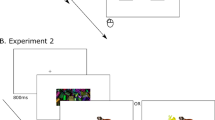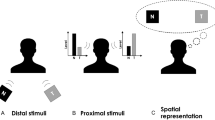Abstract
Visual capture and the ventriloquism aftereffect resolve spatial disparities of incongruent auditory visual (AV) objects by shifting auditory spatial perception to align with vision. Here, we demonstrated the distinct temporal characteristics of visual capture and the ventriloquism aftereffect in response to brief AV disparities. In a set of experiments, subjects localized either the auditory component of AV targets (A within AV) or a second sound presented at varying delays (1–20 s) after AV exposure (A2 after AV). AV targets were trains of brief presentations (1 or 20), covering a ±30° azimuthal range, and with ±8° (R or L) disparity. We found that the magnitude of visual capture generally reached its peak within a single AV pair and did not dissipate with time, while the ventriloquism aftereffect accumulated with repetitions of AV pairs and dissipated with time. Additionally, the magnitude of the auditory shift induced by each phenomenon was uncorrelated across listeners and visual capture was unaffected by subsequent auditory targets, indicating that visual capture and the ventriloquism aftereffect are separate mechanisms with distinct effects on auditory spatial perception. Our results indicate that visual capture is a ‘sample-and-hold’ process that binds related objects and stores the combined percept in memory, whereas the ventriloquism aftereffect is a ‘leaky integrator’ process that accumulates with experience and decays with time to compensate for cross-modal disparities.




Similar content being viewed by others
References
Angelaki DE, Gu Y, DeAngelis GC (2009) Multisensory integration. Curr Opin Neurobiol 19(4):452–458
Battaglia PW, Jacobs RA, Aslin RN (2003) Bayesian integration of visual and auditory signals for spatial localization. J Opt Soc Am A: 20(7):1391–1397
Bertelson P, Radeau M (1981) Cross-modal bias and perceptual fusion with auditory-visual spatial discordance. Percept Psychophys 29(6):578–584
Bertelson P, Frissen I, Vroomen J, de Gelder B (2006) The aftereffects of ventriloquism: patterns of spatial generalization. Percept Psychophys 68(3):428–436
Bonath B, Noesselt T, Martinez A, Mishra J, Schwiecker K, Heinze HJ, Hillyard SA (2007) Neural basis of the ventriloquist illusion. Curr Biol 17:1697–1703
Bonath B, Noesselt T, Krauel K, Tyll S, Tempelmann C, Hillyard SA (2014) Audio-visual synchrony modulates the ventriloquist illusion and its neural/spatial representation in the auditory cortex. NeuroImage 98:425–434
Bruns P, Röder B (2015) Sensory recalibration integrates information from the immediate and the cumulative past. Sci Rep 5:12739. doi:10.1038/srep12739
Chen L, Vroomen J (2013) Intersensory binding across space and time: a tutorial review. Atten Percept Psychophys 75(5):790–811
Cui Q, Razavi B (2010) Perception of auditory, visual, and egocentric spatial alignment adapts differently to changes in eye position. J Neurophysiol 103(2):1020–1035
Cui QN, Bachus L, Knoth E, O’Neill WE, Paige GD (2008) Eye position and cross-sensory learning both contribute to prism adaptation of auditory space. Prog Brain Res 171(08):265–270
Dobreva MS, O’Neill WE, Paige GD (2012) Influence of age, spatial memory, and ocular fixation on localization of auditory, visual, and bimodal targets by human subjects. Exp Brain Res 223(4):441–455
Eramudugolla R, Kamke MR, Soto-Faraco S, Mattingley JB (2011) Perceptual load influences auditory space perception in the ventriloquist aftereffect. Cognition 118(1):62–74
Frissen I, Vroomen J, de Gelder B, Bertelson P (2003) The aftereffects of ventriloquism: are they sound-frequency specific? Acta Psychol 113(3):315–327
Frissen I, Vroomen J, de Gelder B, Bertelson P (2005) The aftereffects of ventriloquism: generalization across sound-frequencies. Acta Psychol 118(1–2):93–100
Frissen I, Vroomen J, de Gelder B (2012) The aftereffects of ventriloquism: the time course of the visual recalibration of auditory localization. See Perceiving 25(1):1–14
Gruters KG, Groh JM (2012) Sounds and beyond: multisensory and other non-auditory signals in the inferior colliculus. Front Neural Circuits 6:96
Hairston WD, Wallace MT, Vaughan JW, Stein BE, Norris JL, Schirillo JA (2003) Visual localization ability influences cross-modal bias. J Cogn Neurosci 15(1):20–29
Howard I, Templeton W (1966) Human spatial orientation. Wiley, New York
Jack CE, Thurlow WR (1973) Effects of degree of visual association and angle of displacement on the “ventriloquism” effect. Percept Motor Skills 37(3):967–979
Kopco N, Lin IF, Shinn-Cunningham BG, Groh JM (2009) Reference frame of the ventriloquism aftereffect. J Neurosci 29(44):13809–13814
Körding KP, Beierholm U, Ma WJ, Quartz S, Tenenbaum JB, Shams L (2007) Causal inference in multisensory perception. PLoS ONE 2(9):e943
Lewald J (2002) Rapid adaptation to auditory-visual spatial disparity. Learn Memory 9(5):268–278
Ma WJ, Beck JM, Latham PE, Pouget A (2006) Bayesian inference with probabilistic population codes. Nat Neurosci 9(11):1432–1438
Magosso E, Cuppini C, Ursino M (2012) A neural network model of ventriloquism effect and aftereffect. PLoS ONE 7(8):e42503
Mendonça C, Escher A, Van de Par S, Colonius H (2015) Predicting auditory space calibration from recent multisensory experience. Exp Brain Res 233(7):1983–1991
Odegaard B, Shams L (2016) The brain’s tendency to bind audiovisual signals is stable but not general. Psychol Sci 27(4):583–591
Odegaard B, Wozny DR, Shams L (2015) Biases in visual, auditory, and audiovisual perception of space. PLoS Comput Biol 11(12):1–23
Odegaard B, Wozny DR, Shams L (2016) The effects of selective and divided attention on sensory precision and integration. Neurosci Lett 614:24–28
Passamonti C, Frissen I, Làdavas E (2009) Visual recalibration of auditory spatial perception: two separate neural circuits for perceptual learning. Eur J Neurosci 30(6):1141–1150
Radeau M, Bertelson P (1974) The after-effects of ventriloquism. Q J Exp Psychol 26(1):63–71
Radeau M, Bertelson P (1978) Cognitive factors and adaptation to auditory-visual discordance. Percept Psychophys 23(4):341–343
Razavi B, O’Neill WE, Paige GD (2007) Auditory spatial perception dynamically realigns with changing eye position. J Neurosci 27(38):10249–10258
Recanzone GH (1998) Rapidly induced auditory plasticity: the ventriloquism aftereffect. Proc Natl Acad Sci USA 95(3):869–875
Rohe T, Noppeney U (2015) Cortical hierarchies perform Bayesian causal inference in multisensory perception. PLoS Biol 13(2):1–18
Sato Y, Toyoizumi T, Aihara K (2007) Bayesian inference explains perception of unity and ventriloquism aftereffect: identification of common sources of audiovisual stimuli. Neural Comput 19(12):3335–3355
Shams L, Beierholm UR (2010) Causal inference in perception. Trends Cogn Sci 14(9):425–432
Thurlow WR, Jack CE (1973) Certain determinants of the “ventriloquism effect”. Percept Motor Skills 36(3):1171–1184
Van Wanrooij MM, Bremen P, Van Opstal JA (2010) Acquired prior knowledge modulates audiovisual integration. Eur J Neurosci 31(10):1763–1771
Wallace MT, Roberson GE, Hairston WD, Stein BE, Vaughan JW, Schirillo JA (2004) Unifying multisensory signals across time and space. Exp Brain Res 158(2):252–258
Wozny DR, Shams L (2011a) Recalibration of auditory space following milliseconds of cross-modal discrepancy. J Neurosci 31(12):4607–4612
Wozny DR, Shams L (2011b) Computational characterization of visually induced auditory spatial adaptation. Front Integr Neurosci 5:75
Wozny DR, Beierholm UR, Shams L (2010) Probability matching as a computational strategy used in perception. PLoS Comput Biol 6(8):e1000871
Zwiers MP, Van Opstal AJ, Paige GD (2003) Plasticity in human sound localization induced by compressed spatial vision. Nat Neurosci 6(2):175–181
Acknowledgements
We thank Martin Gira and Robert Schor for their technical assistance. Research was supported by NIDCD Grants P30 DC-05409 and T32 DC-009974-04 (Center for Navigation and Communication Sciences), NEI Grants P30-EY01319 and T32 EY-007125-25 (Center for Visual Science), and an endowment by the Schmitt Foundation.
Author information
Authors and Affiliations
Corresponding author
Rights and permissions
About this article
Cite this article
Bosen, A.K., Fleming, J.T., Allen, P.D. et al. Accumulation and decay of visual capture and the ventriloquism aftereffect caused by brief audio-visual disparities. Exp Brain Res 235, 585–595 (2017). https://doi.org/10.1007/s00221-016-4820-4
Received:
Accepted:
Published:
Issue Date:
DOI: https://doi.org/10.1007/s00221-016-4820-4




